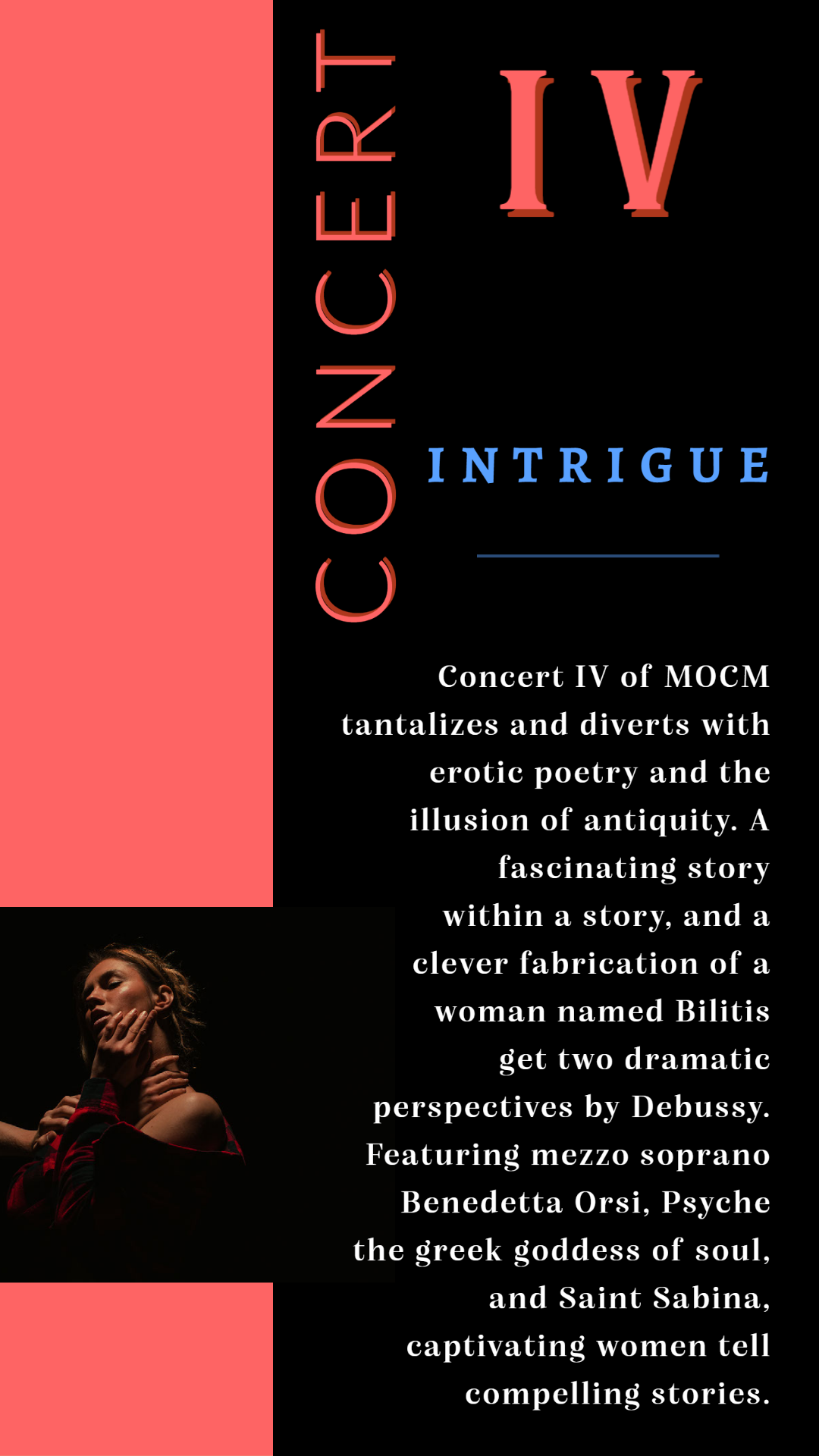

Chansons de Bilitis (1897)
Claude Debussy
II. La chevelure
Benedetta Orsi, mezzo soprano
Hugh Hinton, piano
IX. Sabina from The Companion Guide to Rome (2013)
Andrew Norman
Andrea Jarrett, violin
Alejandro Valdepeñas, viola
Yin Xiong, cello
Death With Interruptions (2014)
Derek Bermel
The Calyx Piano Trio
Catherine French, violin
Jennifer Lucht, cello
Nina Ferrigno, piano
** intermission **
Psyché
Manuel de Falla
Benedetta Orsi, Mezzo soprano
Andrea Jarrett, violin
Nadine Hur, flute
Alejandro Valdepeñas, viola
Yin Xiong, cello
Megan Stout, harp
Les chansons de Bilitis (1901)
Claude Debussy
musique de scène devant accompagner la récitation de douze poèmmes de Pierre Louÿs pour récitant, deux flûtes, deux harpes et célesta
- Chant pastoral
- Les Comparaisons
- Les Contes
- Chanson (ombre du bois)
- La Partie d’osselets
- Bilitis
- Le Tombeau sans nom
- Les Courtesanes égyptiennes
- L’Eau pure du bassin
- La Danseuse aux crotales
- Le Souvenir de Mnasidica
- La Pluie au matin
Florent Ghys, narrator
Nadine Hur, Jennifer Gartley, flutes
Megan Stout, Caroline Robinson, harps
Nina Ferrigno, celeste

Debussy / Chansons de Bilitis (1897) & (1901)
Les Chansons de Bilitis is a collection of 143 erotic, mainly lesbian, prose poems by Pierre Louÿs published in Paris in 1894. They are in the style of Sappho, the ancient Greek poet from the island of Lesbos known for her lyric poetry, and meant to be sung while accompanied by music. Louÿs claimed he had translated the original poetry from Ancient Greek, that they were found on the walls of a tomb in Cyprus, and that they were written by a woman called Bilitis. Bilitis was claimed to be a contemporary of Sappho and a courtesan. In fact, Louÿs wrote the poems himself and fabricated an elaborate backstory to lend authenticity to the “discovery” of the poems.The Songs of Bilitis are written in three cycles, each representing a stage of Bilitis’ life: ‘Bucolics in Pamphylia’, ‘Elegies at Mytilene’, and ‘Epigrams in the Isle of Cyprus’. The stages are from childhood and first sexual encounters, exploration of homosexual sensuality and, finally, life as a courtesan. Each cycle ends marking a new, deeper phase of human experience, emotion and sexual exploration. The poems deceived even expert scholars upon publication. Though the literary ruse was eventually exposed, it did nothing to diminish the literary importance of Louÿs’ open celebration of lesbian sexuality.
Claude Debussy was close friends with Louÿs and was seemingly intrigued by The Songs of Bilitis enough to create three different adaptations of the work. The first, in 1897, is a setting of three poems for voice and piano, which paints a dreamy picture of antiquity. The use of gentle accompaniment and whole-tone harmony paints a picture of serenity and sensuality. In 1901, Debussy adapted twelve of the poems into a ‘theatre’ piece for narrator, and the unusual ensemble of two flutes, two harps and celesta. The nature of the instrumentation creates both a sense of antiquity and femininity helping to set the scene for the recited poems. The rhythm of the spoken French language creates its own sense of “transport” and entry into a different sound world. Les chansons de Bilitis (1901) was performed only once in full realization, in Venice, and with the addition of a mime. The third adaptation of the work (not heard tonight) is the Six Epigraphes Antiques for piano 4-hands written in 1914. This work was not published during Debussy’s life.
Chansons de Bilitis (1897)
French source: Pierre Louÿs
Translation © Richard Stokes, author of A French Song Companion (Oxford, 2000)
La flûte de Pan
Pour le jour des Hyacinthies, il m’a donné une syrinx
faite de roseaux bien taillés, unis avec la blanche cire
qui est douce à mes lèvres comme le miel.
Il m’apprend à jouer, assise sur ses genoux; mais je
suis un peu tremblante. Il en joue après moi, si
doucement que je l’entends à peine.
Nous n’avons rien à nous dire, tant nous sommes
près l’un de l’autre; mais nos chansons veulent se
répondre, et tour à tour nos bouches s’unissent sur la flûte.
Il est tard; voici le chant des grenouilles vertes qui
commence avec la nuit. Ma mère ne croira jamais que
je suis restée si longtemps à chercher ma ceinture perdue.
The flute of Pan
For Hyacinthus day he gave me a syrinx made of
carefully cut reeds, bonded with white wax which tastes
sweet to my lips like honey.
He teaches me to play, as I sit on his lap; but I am
a little fearful. He plays it after me, so gently that I
scarcely hear him.
We have nothing to say, so close are we one to
another, but our songs try to answer each other, and
our mouths join in turn on the flute.
It is late; here is the song of the green frogs that
begins with the night. My mother will never believe
I stayed out so long to look for my lost sash.
La Chevelure
Il m’a dit: «Cette nuit, j’ai rêvé. J’avais ta chevelure
autour de mon cou. J’avais tes cheveux comme un
collier noir autour de ma nuque et sur ma poitrine.
«Je les caressais, et c’étaient les miens; et nous
étions liés pour toujours ainsi, par la même chevelure
la bouche sur la bouche, ainsi que deux lauriers n’ont
souvent qu’une racine.
«Et peu à peu, il m’a semblé, tant nos membres
étaient confondus, que je devenais toi-même ou que
tu entrais en moi comme mon songe.»
Quand il eut achevé, il mit doucement ses mains sur
mes épaules, et il me regarda d’un regard si tendre,
que je baissai les yeux avec un frisson.
The tresses of hair
He said to me: ‘Last night I dreamed. I had your
tresses around my neck. I had your hair like a black
necklace all round my nape and over my breast.
‘I caressed it and it was mine; and we
were united thus for ever by the same tresses,
mouth on mouth, just as two laurels
often share one root.
‘And gradually it seemed to me, so intertwined
were our limbs, that I was becoming you, or you were
entering into me like a dream.’
When he had finished, he gently set his hands on
my shoulders and gazed at me so tenderly that I lowered
my eyes with a shiver.
Le tombeau des Naiades
Le long du bois couvert de givre, je marchais; mes cheveux
devant ma bouche se fleurissaient de petits glaçons, et
mes sandales étaient lourdes de neige fangeuse et tassée.
Il me dit: «Que cherches-tu?»—«Je suis la trace du satyre.
Ses petits pas fourchus alternent comme des trous dans
un manteau blanc.» Il me dit: «Les satyres sont morts.
«Les satyres et les nymphes aussi. Depuis trente ans il
n’a pas fait un hiver aussi terrible. La trace que tu vois est
celle d’un bouc. Mais restons ici, où est leur tombeau.»
Et avec le fer de sa houe il cassa la glace de la source
où jadis riaient les naïades. Il prenait de grands
morceaux froids, et les soulevant vers le ciel pâle, il
regardait au travers.
The tomb of the Naiads
Along the frost-bound wood I walked; my hair across
my mouth, blossomed with tiny icicles, and my
sandals were heavy with muddy, packed snow.
He said to me: ‘What do you seek?’ ‘I follow the satyr’s track.
His little cloven hoof-marks alternate like holes in
a white cloak.’ He said to me: ‘The satyrs are dead.
‘The satyrs and the nymphs too. For thirty years there
has not been so harsh a winter. The tracks you see are those
of a goat. But let us stay here, where their tomb is.’
And with the iron head of his hoe he broke the ice of
the spring, where the naiads used to laugh. He picked up
some huge cold fragments, and, raising them to the pale sky,
gazed through them.
Les Chansons de Bilitis (1901)
musique de scène devant accompagner la récitation de douze poèmmes de Pierre Louÿs pour récitant, deux flûtes, deux harpes et célesta
French source: Pierre Louÿs
English translation © Carmella Cao
1. Chant Pastorale
Il faut chanter un chant pastoral, invoquer Pan,
dieu du vent d’été.
Je garde mon troupeau et Sélénis le sien, à
l’ombre ronde d’un olivier qui tremble.
Sélénis est couchée sur le pré.
Elle se lève et court, ou cherche des cigales, ou
cueille des fleurs avec des herbes, ou lave son
visage dans l’eau fraîche du ruisseau.
Moi, j’arrache la laine au dos blond des
moutons pour en garnir ma quenouille, et je
file. Les heures sont lentes.
Un aigle passe dans le ciel.
L’ombre tourne, changeons de place la
corbeille de figues et la jarre de lait.
Il faut chanter un chant pastoral, invoquer Pan,
dieu du vent d’été.
Pastoral Song
One must sing a pastoral song, invoke Pan,
god of the summer wind.
I watch my herd and Selenis hers, under the
round shade of the trembling olive tree.
Sélénis lies in the meadow. She rises and runs
or looks for grasshoppers, or gathers flowers
with the grass, or washes her face in the fresh
water of the stream.
Me, I pull the wool from the blond backs of the
sheep to stock my distaff and I spin.
The hours are slow.
An eagle passes in the sky.
The shadow turns, let’s move the basket of figs
and the jar of milk. One must sing a pastoral
song, invoke Pan, god of the summer wind.
2. Les Comparaisons
Bergeronnette, oiseau de Kypris, chante avec
nos premiers désirs! Le corps nouveau des
jeunes filles se couvre de fleurs comme la
terre. La nuit de tous nos rêves approche et
nous en parlons entre nous.
Parfois, nous comparons ensemble nos beautés
si différentes, nos chevelures déjà longues, nos
jeunes seins encore petits, nos pubertés rondes
comme des cailles et blotties sous la plume
naissante.
Hier je luttai de la sorte contre Melanthô, mon
aînée. Elle était fière de sa poitrine qui venait
de croître en un mois, et, montrant ma tunique
droite, elle m’avait appelée: Petite enfant.
Pas un homme ne pouvait nous voir, nous nous
mîmes nues devant les filles, et, si elle vainquit
sur un point, je l’emportait de loin sur les
autres. Bergeronnette, oiseau de Kypris, chante
avec nos premiers désirs!
The Comparisons
Wagtail, bird of Kypris, sing with our first
desires. The fresh body of young girls bloom
with flowers like the earth. The night of all our
dreams approaches and we speak of it between
us.
Sometimes, we compare together, our different
beauties, our already long hair, our young
breasts still small, our puberties round like
quails and nestled under the budding down.
Yesterday I fought in this way against
Melanthô, my elder. She was proud of her
chest that had grown in a month, and, pointing
out my straight tunic, she had called me: Little
child.
No man could see us, we placed ourselves
naked before the girls, and, if she conquered
upon one point, I far vanquished her on the
others. Wagtail, bird of Kypris, sing with our
first desires.
3. Les Contes
Je suis aimée des petits enfants; dès qu’ils me
voient, ils courent à moi et s’accrochent à ma
tunique et prennent mes jambes dans leurs
petits bras.
S’ils ont cueilli des fleurs, ils me les donnent
toutes; s’ils ont pris un scarabée, ils le mettent
dans ma main; s’ils n’ont rien, ils me caressent
et me font asseoir devant eux.
Alors ils m’embrassent sur la joue, ils posent
leurs têtes sur mes seins; ils me supplient avec
les yeux. Je sais bien ce que cela veut dire.
Cela veut dire: « Bilitis chérie, redis-nous, car
nous sommes gentils, l’histoire du héros
Perseus ou la mort de la petite Hellé. »
The Stories
I am loved by the little children; as soon as
they see me, they run to me and cling to my
tunic and take my legs in their little arms.
If they have picked flowers, they give them all
to me; if they have caught a beetle, they put it
in my hand; if they have nothing, they caress
me and make me sit in front of them.
Then they kiss me on the cheek, they put their
heads upon my breasts; they plead with their
eyes. I know very well what that means.
That means: “Bilitis dear, retell us because we
are good, the story of the hero Perseus or the
death of the little Hellé.”
4. Chanson (ombre du bois)
« Ombre du bois où elle devait venir, dis-moi,
où est allée ma maîtresse? — Elle est
descendue dans la plaine. — Plaine, où est
allée ma maîtresse? — Elle a suivi les bords du fleuve.
— Beau fleuve qui l’a vue passer, dis-moi, estelle
près d’ici? — Elle m’a quitté pour le
chemin. — Chemin, la vois-tu encore? — Elle
m’a laissé pour la route.
— O route blanche, route de la ville, dis-moi,
où l’as-tu conduite? — A la rue d’or qui entre à
Sardes. — O rue de lumière, touches-tu ses
pieds nus? — Elle est entrée au palais du roi.
— O palais, splendeur de la terre, rends-lamoi!
— Regarde, elle a des colliers sur les
seins et des houppes dans les cheveux, cent
perles le long des jambes, deux bras autour de la taille. »
Song (Shadow of the woods)
“Shadow of the woods where she was
supposed to come, tell me, where has my
mistress gone? – She has gone to the plain. –
Plain, where has my mistress gone? – She
followed the banks of the river.
– Beautiful river who saw her pass, tell me, is
she close to here? – She left me for the path. –
Path, do you see her still? – She left me for the road.
– Oh white road, road to the city, tell me,
where have you led her? – To the street of gold
into Sardes. – Oh road of light, do you touch
her bare feet? – She entered the king’s palace.
– Oh palace, spendor of the earth, give her
back to me! – Look, she has necklaces on her
breasts and circlets in her hair, one hundred
pearls down to her legs, two arms around her waist.
5. La Partie d’osselets
Comme nous l’aimions toutes les deux, nous
l’avons joué aux osselets. Et ce fut une partie
célèbre. Beaucoup de jeunes filles y assistaient.
Elle amena d’abord le coup des Kyklôpes, et
moi, le coup de Solôn. Mais elle, le Kallibolos,
et moi, me sentant perdue, je priais la déesse!
Je jouai, j’eus l’Epiphénôn, elle le terrible coup
de Khios, moi l’Antiteukhos, elle le Trikhias, et
moi le coup d’Aphroditê qui gagna l’amant disputé.
Mais la voyant pâlir, je la pris par le cou et je
lui dis tout près de l’oreille (pour qu’elle seule
m’entendit): « Ne pleure pas, petite amie, nous
le laisserons choisir entre nous. »
The Games of Jacks
As we both loved him, we played for him with
jacks. And this was a famous match. Many girls watched.
She began first with the stroke of Kyklôpes,
and I, the stroke of Solon. But she the
Kallibolos, and I feeling lost, I prayed to the goddess.
I played, I had Epiphénon, she the terrible
stroke of Khios, me the Antiteukhos, she the
Trikhias, and me the stroke of Aphroditê
which won the contested lover.
But seeing her turn pale, I took her by the neck
and I told her very close to her ear so only she
heard me: “Don’t cry, my little friend, we will
let him choose between us.”
6. Bilitis
Une femme s’enveloppe de laine blanche. Une
autre se vêt de soie et d’or. Une autre se couvre
de fleurs, de feuilles vertes et de raisins.
Moi je ne saurais vivre que nue. Mon amant,
prends-moi comme je suis: sans robe ni bijoux
ni sandales, voici Bilitis toute seule.
Mes cheveux sont noirs de leur noir et mes
lèvres rouges de leur rouge. Mes boucles
flottent autour de moi libres et rondes comme
des plumes.
Prends moi telle que ma mère m’a faite dans
une nuit d’amour lointaine, et si je te plais ainsi
n’oublie pas de me le dire.
Bilitis
A woman wraps herself in white wool.
Another wears silk and gold. Another covers
herself with flowers, green leaves, and grapes.
Me, I would only know to live naked. My
lover, take me as I am: without clothes or
jewels or sandals, here is Bilitis all alone.
My hair is black from its blackness and my lips
are red from its redness. My curls float around
me free and round like feathers.
Take me as my mother made me in a night of
far away love, and if I please you thus don’t
forget to tell me.
7. Le Tombeau sans nom
Mnasidika m’ayant prise par la main me mena
hors des portes de la ville, jusqu’à un petit
champ inculte où il y avait une stèle de marbre.
Et elle me dit: « Celle-ci fut l’amie de ma mère.»
Alors je sentis un grand frisson, et sans cesser
de lui tenir la main, je me penchai sur son
épaule, afin de lire les quatre vers entre la
coupe creuse et le serpent:
« Ce n’est pas la mort qui m’a enlevée, mais les
Nymphes des fontaines. Je repose ici sous une
terre légère avec la chevelure coupée de
Xanthô. Qu’elle seule me pleure. Je ne dis pas
mon nom. »
Longtemps nous sommes restées debout, et
nous n’avons pas versé la libation. Car
comment appeler une âme inconnue d’entre les
foules de l’Hadès?
The Tomb Without a Name
Mnasidika having taken me by the hand led me
out of the gates of the city up to a small
uncultivated field where there was a marble
headstone. And she said to me: “She here was
my mother’s lover.”
Then I felt a great chill, and still holding her
hand, I leaned against her shoulder, to read the
four verses between the broken cup and the
serpent:
“It is not death that has carried me away, but
the Nymphs of the fountains. I rest here under
the light earth with the cut hair of Xanthô. Let
her alone cry for me. I do not say my name.”
We stood there for a long time and we did not
pour an offering. Because how can we call an
unknown soul among the masses in Hades?
8. Les Courtesanes égyptiennes
Je suis allée avec Plangon chez les courtisanes
égyptiennes, tout en haut de la vieille ville.
Elles ont des amphores de terre, des plateaux
de cuivre et des nattes jaunes où elles
s’accroupissent sans effort.
Leurs chambres sont silencieuses, sans angles
et sans encoignures, tant les couches
successives de chaux bleue ont émoussé les
chapiteaux et arrondi le pied des murs.
Elles se tiennent immobiles, les mains posées
sur les genoux. Quand elles offrent la bouillie
elles murmurent: « Bonheur. » Et quand on les
remercie, elles disent: « Grâce à toi. »
Elles comprennent le hellène et feignent de le
parler mal pour se rire de nous dans leur
langue; mais nous, dent pour dent, nous
parlons lydien et elles s’inquiètent tout à coup.
The Egyptian Courtesans
I went with Plangon to the home of the
Egyptian courtesans, above the old city. They
have vases of clay, plates of copper and yellow
mats where they squat without effort.
Their rooms are quiet, without angles and
without corners, so much the successive layers
of blue lime have dulled the pillars and
rounded the feet of the walls.
They stay motionless, their hands resting on
their knees. When they offer the porridge they
murmur “happiness” and when we thank them
they say “Thanks to you.”
They understand Hellenic, and feign to speak it
poorly, so as to laugh at us in their own
language; but as for us, word for word, we
speak Lydian and they are suddenly worried.
9. L ‘Eau pure du bassin
« Eau pure du bassin, miroir immobile, dis-moi
ma beauté. — Bilitis, ou qui que tu sois,
Téthys peut-être ou Amphritritê, tu es belle,
sache-le.
« Ton visage se penche sous ta chevelure
épaisse, gonflée de fleurs et de parfums. Tes
paupières molles s’ouvrent à peine et tes flancs
sont las des mouvements de l’amour.
« Ton corps fatigué du poids de tes seins porte
les marques fines de l’ongle et les taches bleues
du baiser. Tes bras sont rougis par l’étreinte.
Chaque ligne de ta peau fut aimée.
— Eau claire du bassin, ta fraîcheur repose.
Reçois-moi, qui suis lasse en effet. Emporte le
fard de mes joues, et la sueur de mon ventre et
le souvenir de la nuit. »
The Pure Water of the Basin
“Pure water of the basin, immobile mirror, tell
me my beauty. – Bilitis, or whoever you are,
Téthys maybe or Amphritritê, know that you
are beautiful.
“Your face tilts beneath your thick hair, full of
flowers and of perfumes. Your soft eyelids
scarcely opened and your hips are weary from
the movements of love.
“Your body tired from the weight of your
breasts carries slight nail marks and the bruises
from lovemaking. Your arms are red from the
embrace. Each line of your skin was loved.
– Clear water of the basin, your freshness rests.
Receive me, who am tired indeed. Carry away
the make-up for my cheeks, and the sweat of
my stomach and the memory of the night.”
10. La Danseuse aux crotales
Tu attaches à tes mains légères tes crotales
retentissants, Myrrhinidion ma chérie, et à
peine nue hors de la robe, tu étires tes
membres nerveux. Que tu es jolie, les bras en
l’air, les reins arqués et les seins rouges!
Tu commences: tes pieds l’un devant l’autre se
posent, hésitent, et glissent mollement. Ton
corps se plie comme une écharpe, tu caresses
ta peau qui frissonne, et la volupté inonde tes
longs yeux évanouis.
Tout à coup, tu claques des crotales! Cambretoi
sur les pieds dressés, secoue les reins, lance
les jambes et que tes mains pleines de fracas
appellent tous les désirs en bande autour de ton
corps tournoyant!
Nous, applaudissons à grands cris, soit que,
souriant sur l’épaule, tu agites d’un
frémissement ta croupe convulsive et musclée,
soit que tu ondules presque étendue, au
rhythme de tes souvenirs.
The Dancer of Crotales
You attach to your light hands your resounding
crotales (ancient metal castanets),
Myrrhinidion my dear, and taking off your
robe you stretch your nervous limbs. How
pretty you are, your arms in the air, your
arched hips and red breasts.
You begin: your feet one in front of the other
posing, hesitant, and softly slide. Your body
bends like a scarf, you caress your shivering
skin, and the volumptousness floods your long
hidden eyes.
All of a sudden you slap the crotales! Bend on
raised feet, shake your hips, fling your legs and
may your hands full of clamour call all the
desires grouped around your turning body!
We applaud with great cries, whether smiling
over your shoulder, you shake and quiver your
convulsive and muscular rear, or whether you
undulate almost sprawling to the rhythm of
your memories.
11. Le Souvenir de Mnasidica
Elles dansaient l’une devant l’autre, d’un
mouvement rapide et fuyant; elles semblaient
toujours vouloir s’enlacer, et pourtant ne se
touchaient point, si ce n’est du bout des lèvres.
Quand elles tournaient le dos en dansant, elles
se regardaient, la tête sur l’épaule, et la sueur
brillait sous leurs bras levés, et leurs
chevelures fines passaient devant leurs seins.
La langueur de leurs yeux, le feu de leurs
joues, la gravité de leurs visages, étaient trois
chansons ardentes. Elles se frôlaient
furtivement, elles pliaient leurs corps sur les
hanches.
Et tout à coup, elles sont tombées, pour
achever à terre la danse molle… Souvenir de
Mnasidika, c’est alors que tu m’apparus, et tout,
hors ta chère image, me fut importun.
The Memory of Mnasidika
They dance one in front of another, with rapid
and elusive movements; they seemed always
desiring to embrace and yet not touching at all,
unless with the tips of their lips.
When they turned their backs in dancing, they
looked at each other, the head on the shoulder,
and the glistening perspiration under their
raised arms, and their fine hair passing before
their breasts.
The languor of their eyes, the fire of their
cheeks, the solemnity of their faces, were three
ardent songs. They furtively brushed against
each other, they bent their bodies at their hips.
Suddenly, they fell, to finish the soft dance on
the ground…Memory of Mnasidika, it is while
you appeared to me, and all, except your dear
image, troubled me.
12. La Pluie au matin
La nuit s’efface. Les étoiles s’éloignent. Voici
que les dernières courtisanes sont rentrées avec
les amants. Et moi, dans la pluie du matin,
j’écris ces vers sur le sable.
Les feuilles sont chargées d’eau brillante. Des
ruisseaux à travers les sentiers entraînent la
terre et les feuilles mortes. La pluie, goutte à
goutte, fait des trous dans ma chanson.
Oh! que je suis triste et seule ici! Les plus
jeunes ne me regardent pas; les plus âgés m’ont
oubliée. C’est bien. Ils apprendront mes vers, et
les enfants de leurs enfants.
Voilà ce que ni Myrtalê, ni Thaïs, ni Glykéra
ne se diront, le jour où leurs belles joues seront
creuses. Ceux qui aimeront après moi
chanteront mes strophes ensemble.
The Morning Rain
The night fades. The stars move away. Here
the last courtesans have returned with lovers.
And me, in the morning rain, I write these
verses in the sand.
The leaves are weighed with brilliant water.
The streams that cross the paths carry away the
earth and the dead leaves. The rain, drop by
drop makes holes in my song.
Oh! how I am sad and alone here! The
youngest don’t look at me; the oldest have
forgotten me. It’s well. They will learn my
verses and the children of their children.
Here is neither Myrtalê, nor Thaïs, nor Glykéra
will say to each other, the day when their
beautiful cheeks will be sunken. Those who
will love after me will sing together my stanzas.
Andrew Norman / Sabina, from the Companion Guide to Rome (2010)
Like many of the buildings in Rome, this piece is the product of a long gestation marked by numerous renovations, accretions, and ground-up reconstructions. What has emerged is a collection of portraits—nine in all—of my favorite Roman churches. The music is, at different times and in different ways, informed by the proportions of the churches, the qualities of their surfaces, the patterns in their floors, the artwork on their walls, and the lives and legends of the saints whose names they bear. The more I worked on these miniatures, the less they had to do with actual buildings and the more they became character studies of imaginary people, my companions for a year of living in the Eternal City.
The last movement of this piece, Sabina, was first written in 2006 for the Janaki Trio, who premiered it at Carnegie Hall. It exists both as a separate work and as part of this collection of pieces. The complete Companion Guide was premiered by the Scharoun Ensemble at Radialsystem V in Berlin on May 30th, 2010.
— Andrew Norman
Derek Bermel / Death with Interruptions (2014)
Death with Interruptions (2014) is a piano trio, written in variation form. The title, which comes from the novel by the Portuguese writer José Saramago, describes the chaos that ensues when one day people mysteriously stop dying. Soon afterwards Death herself enters the narrative and falls madly in love with a cellist. I was intrigued by Saramago’s portrait of death as a character, viewed through a multitude of prisms: the mysterious, the impulsive, the ridiculous, and the dispassionate.
A simple melody begins the trio and it moves through a series of transformations in mood, texture, and speed. Variations continually return to the musical heartbeat present in the opening song. Through disparate textures and tempi, the obsessive rhythm emerges as a fixed element bridging musical landscapes. I began writing the work in the months following the passing of my father Albert Bermel, to whom it is dedicated; he was a playwright, a teacher, a translator, and a great lover of farce, who never seemed to believe that Death would visit one day.
— Derek Bermel
In Manuel de Falla’s Psyché, the female singer speaks to a sleeping Psyché asking her to wake up, dry her tears, and experience nature full of love. The piece is a sort of homage to Debussy for one cannot but think of Debussy’s Afternoon of a Faun as the pastoral scene in Psyché is set. However there exists a darkness underneath and Falla uses registration (both the flute and voice are low and rich) and chromaticism to convey this. The work received its premiere in Granada in 1924 and Fall includes this introduction in the score:
“Remembering that Philip V and his wife Elizabeth Farnese lived in the Alhambra palace around 1730, as I composed this Psyché I imagined a little courtly concert which might have taken place in the Queen’s bedchamber, which, situated at the top of a high tower, looks out over a truly magnificent view.”
De Falla / Psyché
By Jean-Frédéric-Emile Aubry
Psyché ! La lampe est morte; éveille-toi.
Le jour te considère
avec des yeux noyés d’amour,
et le désir nouveau de te servir encore.
Le miroir, confident de ton visage en pleurs,
reflète, ce matin, lac pur parmi des fleurs,
Un ciel laiteux ainsi qu’une éternelle aurore.
Midi s’approche et danse,
ivre sur ses pieds d’or.
Tends-lui les bras, sèche tes pleurs ;
dans un essor abandonne, Psyché,
la langueur de ta couche.
L’oiseau chant au sommet de l’arbre,
le soleil sourit d’aise
en voyant l’universel éveil,
et le Printemps s’étire,
une rose à la bouche.
Psyché
By Jean-Frédéric-Emile Aubry
Psyché! The lamp has gone out ; awaken!
The day contemplates you
with eyes flooded with love
and a new desire to serve you again.
The mirror, confidant of your tearful face,
Reflects this morning a pure lake among flowers,
A milk-white sky like an eternal dawn.
Noon approaches and dances,
Intoxicated on his golden feet.
Reach your arms out to him, dry your tears;
In a flight, abandon the languor
of your bed, Psyche.
The bird sings at the top of the tree,
The sun smiles with pleasure
on seeing this universal awakening,
and Spring stretches,
a rose in his mouth.
Translation copyright © by Emily Ezust, from the LiederNet Archive — https://www.lieder.net/


Alejandro Valdepeñas, violist
Originally from Toronto, Alejandro Valdepeñas enjoys a multi-faceted career as a violinist and violist. He joined the St. Louis Symphony Orchestra as Associate Principal Viola at the start of the 2022/2023 season.
Valdepeñas made his solo debut on violin at the age of 9 with the Toronto Symphony Orchestra and Sarah Chang. Recent engagements include performances and recordings with the Amici Chamber Ensemble and the Toronto Symphony Orchestra Chamber Soloists. He has spent multiple summers as a violinist with the Santa Fe Opera and has also performed with the Calgary Philharmonic Orchestra.
In the summers, Valdepeñas has performed at the Aspen Music Festival and School and Norfolk Chamber Music Festival at Yale. His future summer engagements include performances at Santa Fe Chamber Music Festival.
Valdepeñas received his Bachelor of Music degree from the New England Conservatory studying with Paul Biss, and his Master of Music degree from Rice University studying with Paul Kantor.
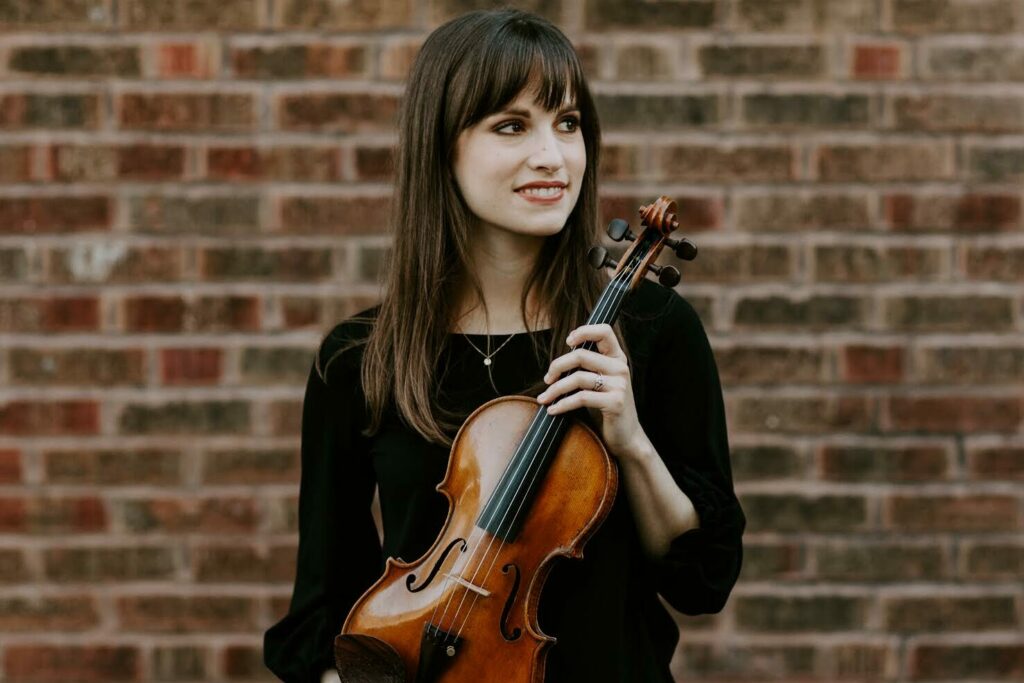
Andrea Jarrett, violinist
Named a 2009 Presidential Scholar in the Arts by the U.S. Department of Education, violinist Andrea Jarrett received her Master of Music Degree from the Shepherd School of Music at Rice University in May 2015. While obtaining her degree, Jarrett was a student of Kathleen Winkler and served as concertmaster of both the chamber and symphony orchestras. She received her Bachelor of Music Degree from the Juilliard School in 2013, where she studied with David Chan. Jarrett joined the second violin section of the St. Louis Symphony Orchestra in September 2015.
Prior to her appointment with the SLSO, Jarrett participated in the 2013 New York String Orchestra Seminar under the direction of Jaime Laredo. While attending Juilliard, Andrea gave the world premiere of composer Neil Rolnick’s concerto for violin and electronics in November 2012, Gardening at Gropius House. In the same year, Jarrett served as concertmaster of the Juilliard Chamber Orchestra. Another highlight during her undergraduate years was her performance of the Mendelssohn Octet in the Chamber Music Society of Lincoln Center’s Meet the Music! Concert Series. Jarrett was a member of the first YouTube Symphony Orchestra in 2009, with concerts in Carnegie Hall under the baton of Michael Tilson Thomas. A native midwesterner, Jarrett has performed as a soloist with the Dearborn, Birmingham-Bloomfield, Toledo, and Ann Arbor symphony orchestras.
During her high school years, Jarrett was a member of the Music Institute of Chicago’s Academy program, where she studied with Almita and Roland Vamos. Jarrett received the Silver Award in Music/Violin from the National Foundation for Advancement in the Arts in January of 2009. Also an active chamber musician, Jarrett was a member of Quartet Polaris, Gold Medal Winners of the 2008 Fischoff National Chamber Music Competition, Junior Division. She performed with Quartet Polaris on NPR’s From the Top. The quartet also performed in The Kennedy Center and Carnegie Weill Hall as part of an East Coast tour through the Music Institute of Chicago.
Jarrett’s summer studies have brought her to many corners of the world. She attended the Taos School of Music in 2013, where she worked closely with the Borromeo and Brentano String Quartets to perform Beethoven’s entire quartet cycle. In 2012, Jarrett traveled to Japan to attend the Pacific Music Festival, where she served as concertmaster under Fabio Luisi. Other festivals attended include Music Academy of the West, Spoleto Festival, Astona International Academy (Switzerland), Heifetz International Music Institute, and Interlochen Arts Camp. Since beginning her position in the SLSO, Andrea has served as Concertmaster of the Lakes Area Music Festival and has performed several seasons with the Sun Valley Summer Symphony.
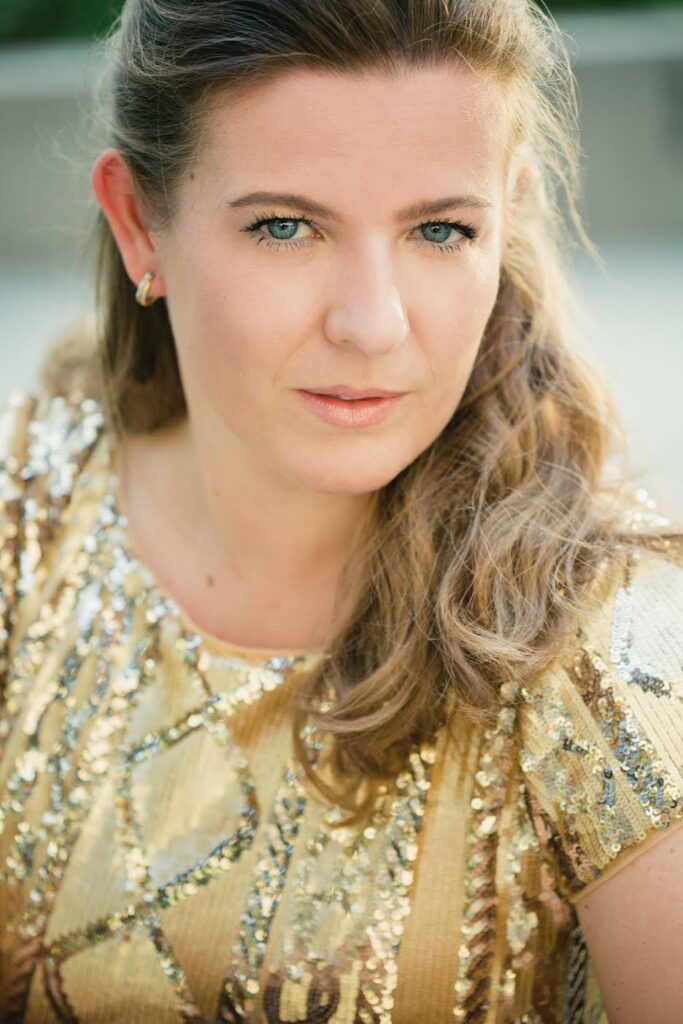
Benedetta Orsi, mezzo soprano
Italian mezzo soprano Benedetta Orsi, now resident in the United States, has been praised by Teresa Berganza as “perfect voice for belcanto”. In February 2022 Benedetta received the Paul Harris Fellow Award in Rome, Italy, as one of the 14 most influential Italian excellences, and only woman, to spread the Italian culture and art abroad. Recently, she was selected by Florida Grand Opera to translate into Spanish the Italian comic opera Il Matrimonio Segreto by Domenico Cimarosa, for their Miami premier.
Mrs. Orsi is one of only a few contemporary mezzo sopranos to have performed all three of Donizetti’s Tudor Operas: Jane Seymour in Anna Bolena, Elisabetta in Maria Stuarda and Sara in Roberto Devereux with Royal Opera Theater in Manchester, UK. Recent performances also include Adalgisa in Norma with Winter Opera St. Louis, the title role of Carmen with Winter Opera St. Louis, Amore Opera in New York, Mamma Lucia in Cavalleria Rusticana with the New Jersey Festival Orchestra, Ulrica in Un Ballo in Maschera with the Miami Lyric Opera and Maddalena in Rigoletto with Amore Opera.
Benedetta’s performance credits include roles in Verdi Rigoletto, Falstaff, Trovatore, Bellini Norma and La Sonnambula, Rossini L’Italiana in Algeri and Il Turco in Italia and Massenet Werther. Along with concert appearances at Carnegie Hall in NYC and throughout Italy, Austria, England, United States and Spain, she has performed with the Arianna String Quartet, St. Louis Philharmonic Orchestra, Gateway Festival Orchestra, New Jersey Festival Orchestra, Boulder Symphony Orchestra, Washington University Symphony Orchestra, Modena Jupiter Orchestra and Orchestra Filarmonica Emiliana.
As a recording artist her first self-produced album, Christmas Around the World, won the double Silver Medal as Best Album and Best Female Vocalist at the Global Music Awards in Los Angeles. Her latest one, La Voix de l’amour, released in December 2019 for the International label Limen Music, won the Gold Medal as Best album. She is currently working on her third album, a collection of Italian arias and art songs for the Swiss recording label BAM International.
Future engagements: INcanto tour in Italy, France and USA, and several Lyric Galas in the Dominican Republic and USA.

Calyx Piano Trio
Catherine French, violinist
Nina Ferrigno, pianist
Jennifer Lucht, cellist
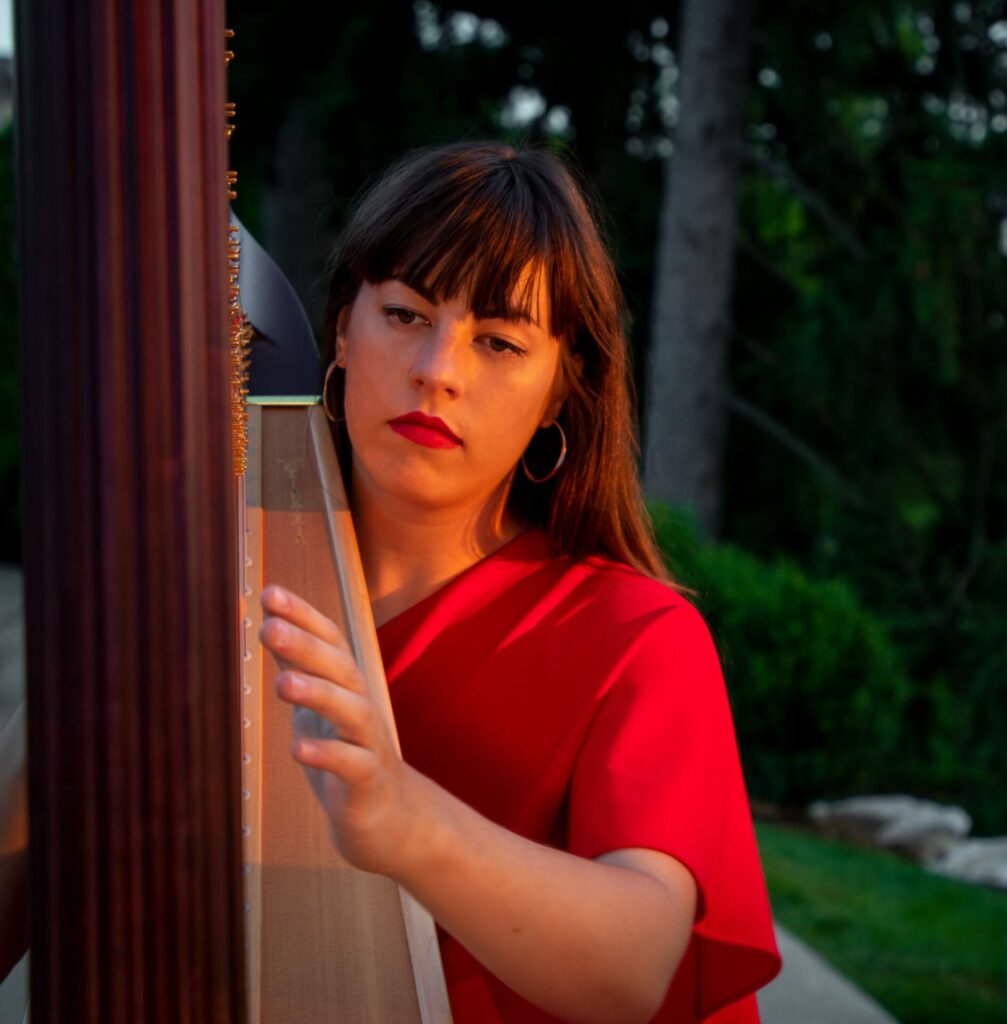
Caroline Robinson, harpist
Caroline has been sharing her passion and love for the harp since the start of her training in 2012. The unique sound and artistry has allowed her to actively perform for a variety of events and venues.
Caroline has built a strong classical background, base for her technique, and knowledge of repertoire for the harp. She was a student of Megan Stout, co-principal harpist of the St. Louis Symphony Orchestra. She is a graduate of the Jacobs School of Music at Indiana University with a Bachelor’s degree in Harp Performance where she studied under the direction of Elżbieta Szmyt, Chairperson of the harp department. She is currently pursuing her Graduate degree at the University of Oklahoma under the direction of Gaye LeBlanc, principal harpist of the Oklahoma City Philharmonic.
Caroline is an active freelance harpist playing with orchestras, chamber ensembles, jazz bands, private events, and recording studios. She has played professionally as the principal harpist for Opera Edwardsville, Union Avenue Opera St. Louis, University of Oklahoma Orchestras, Norman Philharmonic, Tulsa Symphony, and the Oklahoma City Philharmonic.
Caroline is currently finishing her first year as a Graduate student at The University of Oklahoma and looks forward to coming back to St. Louis to play harp in the city and visit family.

Florent Ghys, narrator
French double bassist and composer Florent Ghys’ music has been described as “highly contrapuntal, intelligent and inventive…” (WQXR-FM), and a “thrilling breed of post-minimal chamber music” (Time Out NY). His pieces “blend elements of minimalism, pop music, and a dose of extravagant wit” (John Schaefer, WNYC) while his cat videos “have attained viral fame” (Alex Ross, The New Yorker).
Ghys has written music for some of today’s most influential ensembles and soloists, including the Bang on a Can All-Stars, New Jersey Symphony Orchestra, So Percussion, Nick Photinos, and Jack Quartet. His music has been performed at the Lincoln Center, BAM, the Barbican Center, MIT, Sydney Opera House, and the Muziekgebouw.
Ghys holds a Maîtrise in ethnomusicology, a Diplôme d’Études Musicales in double bass performance, a M.M. in music theory and composition, a Masters of Fine Arts, and a PhD in music composition and technology from Princeton University.
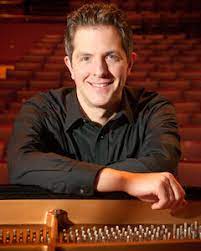
Hugh Hinton, pianist
Hailed for his “aristocratic approach to music making” (Cleveland Plain Dealer) and called “an exceptionally fine interpreter of contemporary music” (Boston Globe), pianist Hugh Hinton has performed throughout the United States and abroad as a soloist, chamber musician, and collaborative pianist. He has performed at New York’s Merkin Hall, Jordan Hall, and Gardner Museum in Boston, Phillips Collection (Washington, DC), and Flagler Museum (Palm Beach, FL.) International appearances include Japan, Korea, Australia, Russia, Ukraine, Moldova, England, Italy, and a tour of the Middle East (Saudi Arabia, Kuwait, Oman, and Syria) sponsored by the United States Information Agency. He has appeared with the Phoenix, Honolulu (Hawaii), and New Hampshire Symphonies, and with the Florida Philharmonic, under the batons of conductors JoAnn Falletta, James Sedares, Derrick Inouye, and James Bolle. Hinton has appeared at many summer music festivals, including performances at Tanglewood’s Seiji Ozawa Hall and at the Monadnock Festival in New Hampshire, where he performed Elliott Carter’s Piano Quintet. He has frequently performed chamber music with members of the Boston Symphony Orchestra in Boston Symphony Orchestra Prelude and Community Chamber Concerts and appeared with members of the St. Louis Symphony at the Missouri Chamber Music Festival. A champion of contemporary music, Hinton performed music by John Cage under the supervision of the composer and premiered compositions by Chinary Ung, Jeffrey Mumford, Osvaldo Golijov, Augusta Read Thomas, and Pulitzer-winner Bernard Rands. A special project was Stockhausen’s Mantra, a landmark 70-minute work for two pianos and electronics performed at the REDCAT recital hall in the Walt Disney Concert Hall in Los Angeles. Hinton had a long musical relationship with Pulitzer-winner Donald Martino, working closely with the composer on many pieces and recording Martino’s 12 Preludes for Solo Piano for New World Records. Hinton’s recordings of contemporary and chamber music have been released by the Naxos, Etcetera, CRI, New World, Newport Classics, and MMC labels, and many can be found on YouTube and music streaming sites. A prizewinner in the Casadesus (Cleveland) and Washington International Piano Competitions, Hinton has also received the Arthur W Foote Award, and the Samuel and Esther Chester Performance Award and was chosen to be a United States Information Service Artistic Ambassador.
Hinton has been a member of the imaginative contemporary music group Core Ensemble since its founding in 1993. He has performed with Core Ensemble in all 50 US states. Core Ensemble has pioneered programs that meld chamber music with theater, advancing a vision of social justice. Core Ensemble programs highlight the music of African American, Latinx, Asian and women composers. Core Ensemble has performed in schools and community centers nationwide, bringing its music beyond the concert hall. Core Ensemble has also developed community-based oral history music theater programs, bringing the stories of marginalized communities, such as farmworkers and immigrants, to the stage.
A native of Louisiana, Hinton earned a Bachelor’s degree from Harvard University and a Master’s and Doctor of Musical Arts degrees from New England Conservatory. He studied piano with Lev Vlassenko, Mykola Suk, Russell Sherman, Wha-Kyung Byun, Jeaneane Dowis, Jonathan Woods, and Constance Carroll. Hinton began lessons at age six, performed in public at age eight, and soon appeared with local orchestras. While in high school, he performed in youth concerts with the Boston and Dallas Symphonies and the New Orleans Philharmonic.
A passionate educator, Hinton has taught piano at the Longy School of Music of Bard College since 1998 and is in demand as an adjudicator for master classes. Hinton also teaches contemporary piano at Longy, introducing students to chance music, playing inside the piano, graphic notation, and performing the music of John Cage. Hinton’s piano students are frequently accepted into DMA programs and can be found in professional careers throughout the music field. In addition to concertizing and teaching, Hinton is active as a church musician, liturgical pianist, and organist and can guide students interested in this area. Hinton is the music director and organist at Plymouth Congregational Church (UCC) in Belmont, MA, and directs campus music activities at Merrimack College (North Andover, MA.)

Jen Gartley, flautist
Jennifer Gartley, flute, was born in Maine and grew up on the Isle of Palms, South Carolina along the barrier islands of the Carolina coast. She graduated with the Doctor of Musical Arts degree from the University of Illinois at Urbana-Champaign with research focusing on contemporary piccolo literature. She counts Jonathan Keeble, Mark Sparks, Katherine Kemler, and Tacy Edwards among her most influential teachers. As an orchestral musician, Jennifer has performed with St. Louis Symphony Orchestra, Opera Theatre of Saint Louis, Sinfonia da Camera, Colorado Music Festival, Bach Society of St. Louis, Fox Theater, Baton Rouge Symphony Orchestra, Illinois Symphony, and the Owensboro Symphony and served as the principal flutist for Winter Opera Saint Louis and Associate Faculty at McKendree University for over a decade. As a concerto soloist, she has been featured with orchestras in Missouri, Illinois, and Louisiana. She has been grateful to perform in masterclasses for William Bennett, Emmanuel Pahud, and Carol Wincenc.
Jennifer is the Artistic Director and founding flutist of Chamber Project Saint Louis, an ensemble dedicated to the performance and commissioning of new and diverse voices in the chamber music field presenting full seasons of adventurous programming in the St. Louis region. As a member of Premier Duo, STL with harpist Megan Stout, she has been featured on concert series across the Midwest. Jennifer holds teaching appointments at Washington University in St. Louis and Webster University.

Jennifer Lucht, cellist
Jennifer Lucht is a native of North Carolina. Praised for “superb” playing by the Boston Globe and “beautiful, finely detailed sound” by the Boston Herald, she has been a concert soloist with orchestras, including the Metamorphosen Chamber Orchestra and Vermont Symphony. As a chamber musician, she has been heard in chamber music performances at the Kennedy Center, Weill Recital Hall, Tanglewood, the Ravinia, and Bravo! Vail Festivals, and on the Greater Philadelphia Performing Artists Series and NPR’s live broadcast “Performance Today.”
Ms. Lucht is currently a member of the Calyx Piano Trio and performs with the Boston Pops Esplanade Orchestra in Boston and on tours throughout the US, Canada, and Japan. She is a Co-Director and founded the Carolina Chamber Music Festival in New Bern, North Carolina. She can be heard in chamber music recordings on the New World, Albany, and Archetype labels. Ms. Lucht received her Bachelor’s and Master’s degrees with a Performer’s Certificate from Indiana University and continued her education with post-graduate studies at the New England Conservatory of Music. Her prominent teachers include Janos Starker, Tsuyoshi Tsutsumi, Laurence Lesser, Colin Carr, and Carter Brey.
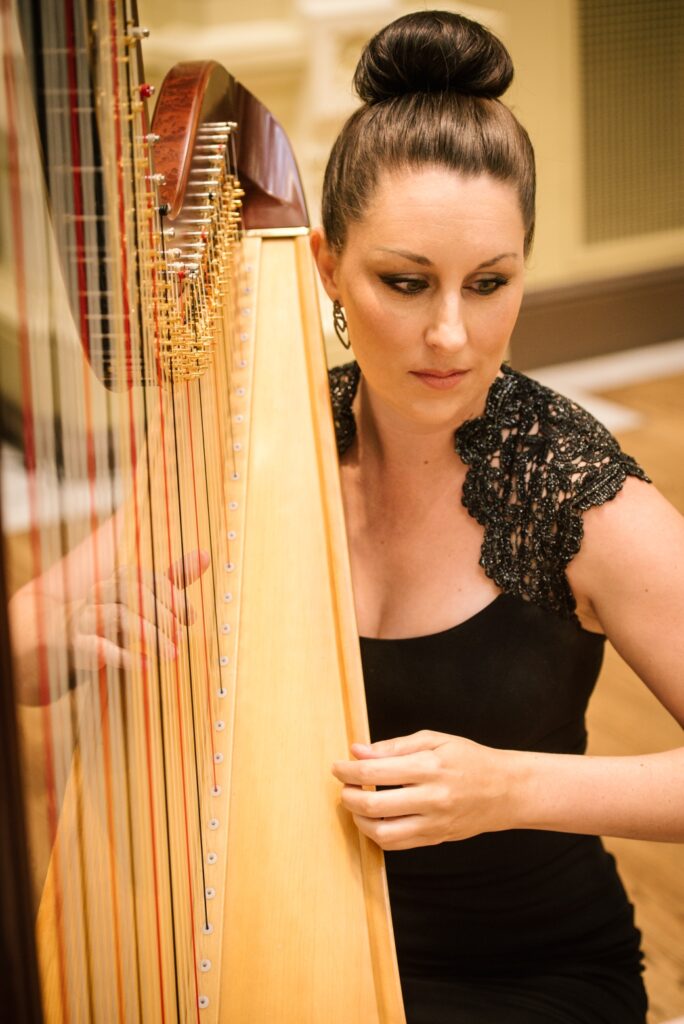
Megan Stout, harpist
Megan appears regularly with the St. Louis Symphony and is passionate about chamber music, performing with the Chamber Music Society of St. Louis and Chamber Project St. Louis. She also plays with the major opera companies in St. Louis, including Opera Theatre, St. Louis, Winter Opera, and Union Avenue Opera. Megan was named the harpist for the MUNY orchestra in 2018. She performs with many ensembles throughout St. Louis and the area including the Fox Theatre, Bach Society of St. Louis, Masterworks Chorale (IL), and Metropolitan Orchestra of St. Louis, to name a few. She has also appeared with the Indianapolis Symphony and Philadelphia Orchestra.
Megan is on faculty at the Department of Music at Washington University in St. Louis and Webster University. In addition, she has a highly successful private teaching studio. Her students have achieved honors including principal harpists of the St. Louis Symphony Youth Orchestra and All State Orchestra, National Youth Orchestra, finalist for the Fox Teen Talent Competition, winner of local concerto competitions, top awards at the Mid America Music Festival Solo Competition, scholarships to Brevard Music Festival (NC), Indiana University, and Northwestern, and they have attended the Young Artists Harp Seminar (GA), Curtis Institute of Music Young Artist Summer Program (PA), and Summer Harp Academy (NC). She is a graduate with both a Bachelor and Master’s Degree in Harp performance from the Jacobs School of Music at Indiana University where she studied with Susann McDonald.
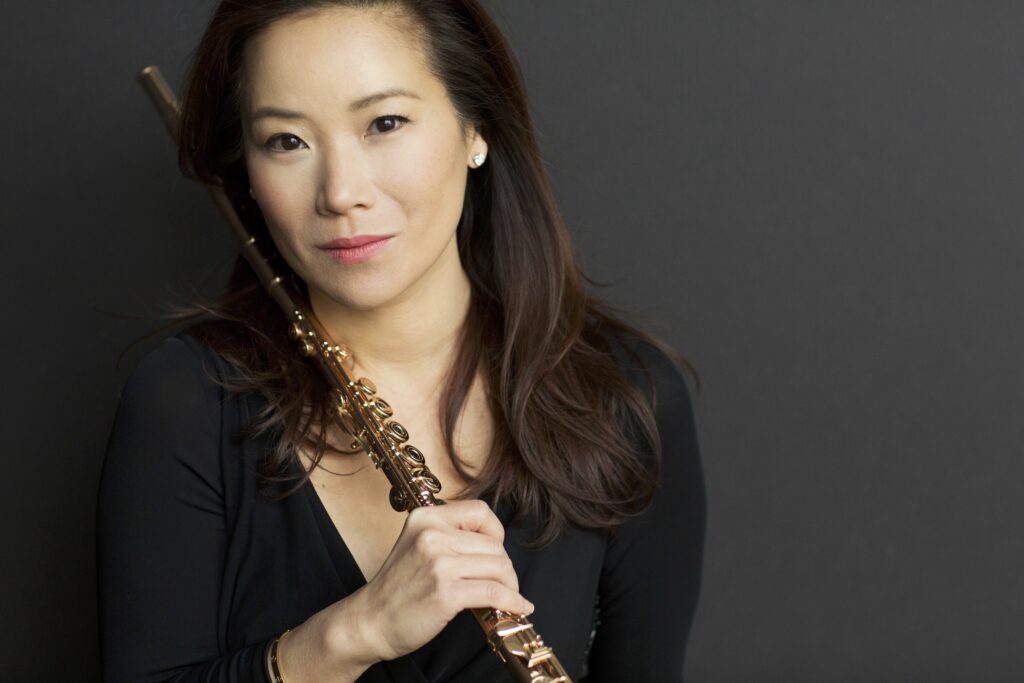
Nadine Hur, flautist
Flutist Nadine Hur enjoys a remarkable career of great diversity and success as an orchestral performer, chamber musician, and soloist.
Ms. Hur is currently the Principal Flutist of the ProMusica Chamber Orchestra. As former Principal Flutist of the Knoxville Symphony Orchestra, she has also appeared as guest Associate Principal Flutist with the Boston Symphony (Tanglewood Music Festival) and with the Minnesota Orchestra. Ms. Hur has performed in numerous prestigious festivals, such as the Mostly Mozart Festival at Lincoln Center, the Bard Music Festival, the Norfolk Chamber Music Festival, the Lincoln Center Outdoors Concert Series, as well as the Embassy Series in Washington D.C., and the Chautauqua Institution.
Ms. Hur is a founding member of the Zephyros Woodwind Quintet, the first woodwind quintet to win both the First Prize and the Grand Prize of the Fischoff National Chamber Music Competition. The Zephyros Quintet subsequently toured the United States extensively under MCM Artists Management.
Ms. Hur began her solo career as a prize winner of the First Japan Flute Convention Competition at the age of 9 and made her concert debut with the Honolulu Symphony at age 11. In addition to the Knoxville Symphony, she has also appeared as a soloist with the Korean Broadcast Symphony (National Symphony), Seoul Philharmonic, Knoxville Symphony and the ProMuscia Chamber Orchestra.
She is a graduate of the Curtis School of Music (Bachelor of Music) and The Juilliard School (Master of Music and Professional Studies), where she studied with Jeffrey Khaner, Julius Baker, and Jeanne Baxtresser.
Ms. Hur enjoys teaching young students, and many have gone on to further their studies at leading universities and conservatories in the United States. Ms. Hur is in continued demand as a guest Masterclass Presenter and Lecturer.
Ms. Hur currently makes her home in St. Louis with her husband, David Kim (Assistant Principal Cellist, St. Louis Symphony), and her son, Alexander.

Nina Ferrigno, pianist
Nina Ferrigno, described by the St. Louis Post Dispatch as “a magnificent pianist,” is a collaborative artist at home in a multitude of diverse musical settings. Her playing is said to be, “…always precise with superb accentuation and warmth of feeling…”. Nina is a founding member of the Boston-based Calyx Piano Trio which excites audiences throughout the United States with expressive ensemble playing and brilliant virtuosity. She has been a featured soloist with such ensembles as the St. Louis Symphony Orchestra, Boston Pops, and the Boston Modern Orchestra Project (BMOP). Recent orchestral keyboard appearances include those with the Chicago Symphony and St. Louis Symphony.
Her festival appearances include those at Tanglewood with members of the Boston Symphony, Banff, Norfolk, and the Skaneateles Festival. She also appears regularly at the Carolina Chamber Music Festival and Missouri Chamber Music Festival where the Calyx Piano Trio holds residencies. Ms. Ferrigno is a graduate of New England Conservatory of Music, where she received degrees with distinction. She is especially committed to bringing classical music to new audiences and expanding the repertoire by working with organizations including Chamber Music America and the Barlow Foundation to commission and perform new works in a variety of settings. The New Music Connoisseur has said of her, “pianist Nina Ferrigno [brings] out the inherent horizontal logic…all the while imparting sonic beauty from end to end.” Nina is a Founder and Director of the Missouri Chamber Music Festival, now in its 13th Season, in St. Louis. She is on the teaching faculty of Washington University and Webster University in St. Louis.